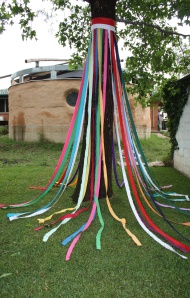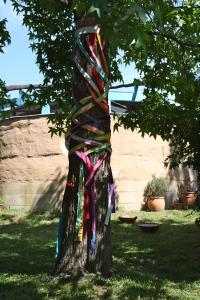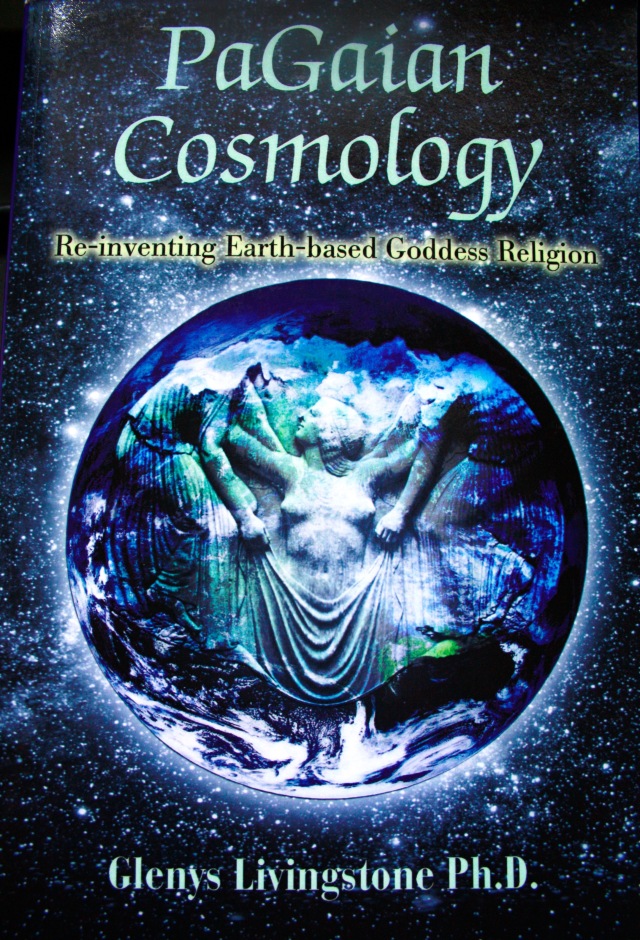Beltaine is commonly understood in recent times to be a celebration of sexuality, and frequently in particular heterosexuality … but this is a simple reduction, and only one of the valencies of a deeper significance of the Seasonal Moment, which is the extant creativity of Sun and Moon in relationship, with Earth. The notable and sensed regional transition of Earth at this time is into Summer … there is clear sense of long hours of light, that just keeps growing: the transition of this cross-quarter Moment is traditionally understood to be from the dark time of the year to the light time (and its opposite Samhain is “Summer’s end”, the transition into the dark time of Winter). Caitlin and John Matthews point out that fertility rituals “may have been symbolic of a far greater exchange than that between men and women – in fact between the elements themselves“[1]. The sexuality celebrated at Beltaine (commonly as “Goddess and God”, but also as Lover and Beloved), is essentially the “pulse of Creativity” itself [2], which extends beyond meiotic sex. Caitlin and John Matthews go on further to say: “the maypole, a comparatively recent manifestation in the history of mystery celebrations, can be seen as the linking of heaven and earth, binding those who dance around it … into a pattern of birth, life and death which lay at the heart of the maze of earth mysteries”. [3]
The traditional red and white ribbons of the Season may represent the fire of the Sun – perhaps the Sun Goddess Aine (whose name forms part of “Beltaine”), or any Sun Goddess – and the white luminosity of the Moon: it may represent the coming together of day and night as they do become one in Earth’s extremities as She moves into Summer. And the traditional twin fires lit at this time may also represent the coming together of the eye of the day and the eye of the night – a marking of Goddess seeing Her land, and bringing forth life and beauty with that vision, with the power of the eye: “the Sun is in the eye” as many Indigenous traditions have believed to be so, and now Western science understands in it own way – the eye is known to have been formed by the same processes as the chlorophyll molecule. In the old Irish language, ‘eye’ and ‘sun’ are the same word – suil [4]. (Dames p.196).

The two fires came to be used to run cattle between for the purpose of burning off the bugs and ticks of Winter as they ran to Summer pasture – and so the fires may be understood to be cleansing. So, I think of the Beltaine fires as the Flame of Love that burns away the psyche’s “bugs and ticks”, and sees the Beauty present, and calls it forth. The Beltaine flames may be a celebration of Sun entering into the eye, into the whole bodymind; the powerful creative evocation of Sun, upon which the Dance of Life depends, and the cleansing power of Love and pleasure.
The “Maypole” or Novapole as we call it in Australia (November being the Season of Beltaine), so frequently reduced to simple phallic symbolism – thanks largely to Freudian thinking of our times, may be more deeply understood as representing cosmic/earth regenerative energy, with various valencies … tree, spine, earth-cosmos connection – the axis mundi. In the Language of the Goddess, Marija Gimbutas refers to column-like art and phallic motifs as “columns of life” and “cosmic pillars” [5]. The dance around it involves both sunwise and counter-sunwise movement – creation and dissolution. Heterosexuality is only one of the valencies of this Cosmic Creativity … it may be time to step deeper into the planetary – less anthropomorphic, less heterosexist – significance of this Seasonal Moment, to understand our human place within the greater story, what we are essentially part of: at least to include this depth in any fertility rites of the Season.
For more, see “Beltane” in Appendix F PaGaian Cosmology, and PaGaian Beltaine 2009
© Glenys Livingstone 2014.
NOTES:
fn 1. Caitlin and John Matthews, TheWestern Way, p. 54.
fn 2. an expression used by Brian Swimme to speak of the deeper significance of sexual allurement, in video 6 of The Earth’s Imagination.
fn 3. Cailtin and John Matthews, The Western Way, p.54.
fn 4. Michael Dames, Ireland: a Sacred Journey, p.196.
fn 5. Marija Gimbutas, The Language of the Goddess, pp 221-235.
REFERENCES:
Dames, Michael. Ireland: A Sacred Journey. ELEMENT BOOKS, 2000.
Gimbutas, Marija. The Language of the Goddess. NY: HarperCollins, 1991.
Livingstone, Glenys. PaGaian Cosmology: Re-inventing Earth-based Goddess Religion. NE: iUniverse, 2005.
Matthews, Caitlin and John. The Western Way. London: Penguin, 1994.
Swimme, Brian. The Earth’s Imagination DVD series.







What a relief to read that May Day, the phrase I use for Beltane because I love flowers is about more than sexuality! Creativity is blossoming – how did we reduce all the wonder to simple sexuality. I simply love your essays. Guess you already know that!
Oh my gods, Glenys, I love this *so* much! I have been sitting with this for the last week, reframing it for myself, moving away from this hetronormative model… and this was exactly what I needed to read *right now*. Thank you, as always.
oh that is so good – thank you for saying so … heteronormative is definitely a pain and only one small part of the valencies of allurement hey. xxo
[…] https://fabiennesmorgana.com/2018/10/29/beltaine-samhain/via Creativity of Beltaine Moment […]